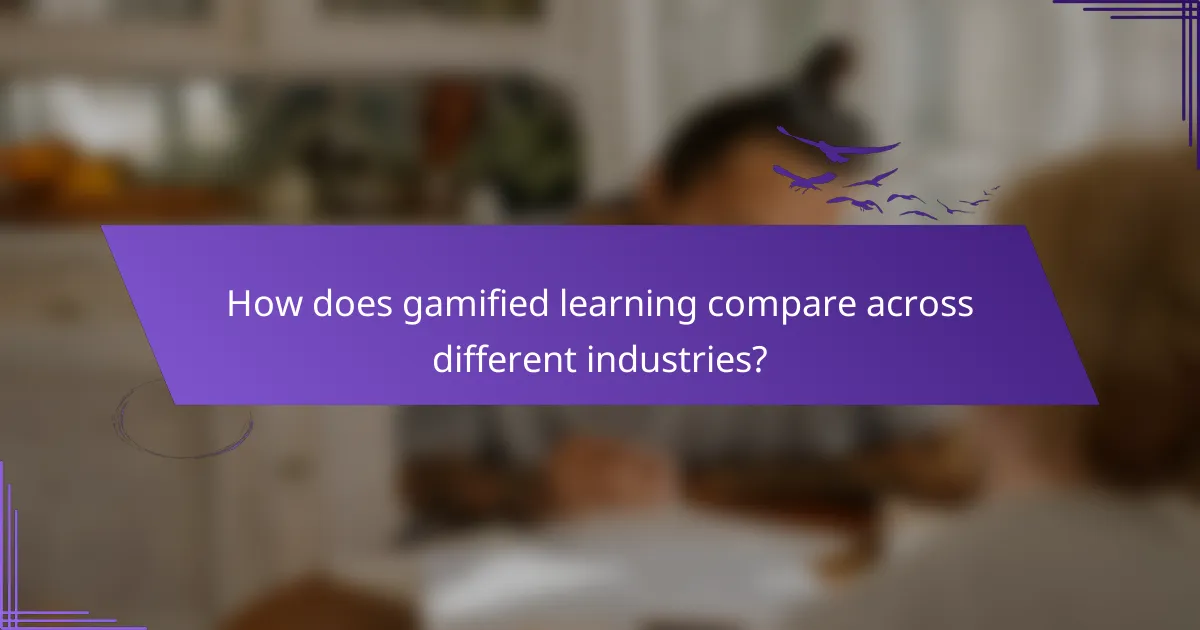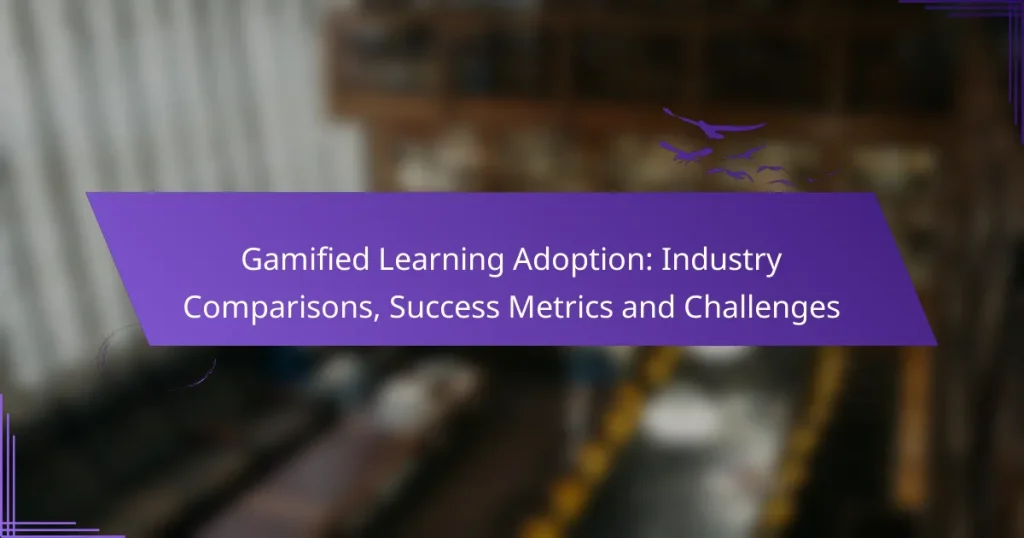Gamified learning has emerged as a transformative approach in online education, enhancing interactivity and enjoyment for learners. Different industries adopt varied strategies and success metrics, with education prioritizing engagement and retention, while corporate training focuses on skill application and performance. Success is measured through completion rates, assessment scores, and user satisfaction, offering valuable insights into the effectiveness of gamified methods.

What are the benefits of gamified learning in online courses?
Gamified learning in online courses enhances the educational experience by making it more interactive and enjoyable. This approach can lead to better engagement, retention, and motivation among learners, ultimately improving their overall performance.
Increased engagement
Gamified learning significantly boosts engagement by incorporating game-like elements such as points, badges, and leaderboards. These features create a sense of competition and achievement, encouraging learners to participate actively in their courses. For instance, online platforms that reward users for completing modules or participating in discussions often see higher completion rates.
To maximize engagement, consider integrating challenges and collaborative tasks that require teamwork. This not only fosters a sense of community but also keeps learners invested in the learning process.
Improved retention rates
Gamification can lead to improved retention rates by making learning more memorable. When learners are emotionally invested in their education through interactive elements, they are more likely to remember the material. Research suggests that gamified experiences can enhance information recall by up to 50% compared to traditional methods.
To enhance retention, use storytelling techniques within the gamified framework. Connecting lessons to a narrative can help learners relate to the content and reinforce their understanding.
Enhanced motivation
Gamified learning enhances motivation by providing immediate rewards and recognition for achievements. This can be particularly effective in online courses, where learners may feel isolated. By introducing elements like progress tracking and rewards, learners are encouraged to push through challenges and stay committed to their goals.
Consider setting clear milestones and offering rewards for reaching them. This strategy can create a sense of accomplishment and encourage continuous effort throughout the course.
Real-time feedback
One of the key benefits of gamified learning is the provision of real-time feedback. This immediate response allows learners to understand their performance and make necessary adjustments quickly. For example, quizzes with instant scoring can help learners identify areas needing improvement right away.
Incorporate mechanisms for feedback that are constructive and supportive. This can include personalized messages or tips based on performance, which can further guide learners in their educational journey.
Personalized learning experiences
Gamified learning allows for personalized experiences tailored to individual learner needs. By adapting challenges and content based on user performance, courses can cater to different learning styles and paces. This customization can lead to a more effective learning experience, as learners feel the material is relevant to their personal goals.
To implement personalization, use data analytics to track learner progress and preferences. This information can help in adjusting the difficulty of tasks or suggesting additional resources that align with their interests and skill levels.

How does gamified learning compare across different industries?
Gamified learning varies significantly across industries, with each sector adopting unique strategies and metrics for success. While the education sector often focuses on engagement and knowledge retention, corporate training emphasizes skill application and performance improvement.
Education sector vs. corporate training
In the education sector, gamified learning primarily aims to enhance student engagement and facilitate knowledge retention through interactive elements like quizzes and leaderboards. For instance, platforms like Kahoot! allow educators to create competitive quizzes that motivate students to participate actively.
Conversely, corporate training utilizes gamification to improve employee performance and retention of job-related skills. Companies may implement simulations and scenario-based learning to replicate real-world challenges, helping employees apply their knowledge in practical situations. This approach can lead to measurable improvements in productivity and job satisfaction.
Healthcare industry applications
Gamified learning in the healthcare industry often focuses on training medical professionals and improving patient outcomes. For example, simulation-based training for surgeons can enhance their skills in a risk-free environment, allowing them to practice complex procedures without endangering patients.
Additionally, gamification can be used to encourage patient adherence to treatment plans. Mobile apps that reward patients for completing medication schedules or attending appointments can increase engagement and improve health outcomes. This approach is particularly effective in managing chronic conditions where ongoing patient involvement is crucial.
Gamification in retail training
In retail training, gamified learning helps employees develop customer service skills and product knowledge through interactive scenarios. Retailers may use role-playing games or point systems to reward employees for mastering new skills or achieving sales targets, fostering a competitive yet collaborative atmosphere.
Moreover, gamification can enhance onboarding processes by making training more engaging and less monotonous. New hires can participate in challenges that familiarize them with store policies and product lines, leading to quicker adaptation and improved performance on the sales floor.

What metrics are used to measure success in gamified learning?
Success in gamified learning is typically measured through a combination of completion rates, assessment scores, user satisfaction surveys, and behavioral analytics. These metrics provide insights into learner engagement, knowledge retention, and overall effectiveness of the gamified approach.
Completion rates
Completion rates indicate the percentage of learners who finish a gamified course or module. High completion rates suggest that the content is engaging and that learners are motivated to progress. Aim for completion rates above 70% to consider a program successful.
To improve completion rates, ensure that the gamified elements are well-integrated and that the learning path is clear. Offering rewards or incentives for finishing can also boost these rates.
Assessment scores
Assessment scores reflect the knowledge and skills acquired by learners through gamified learning. These scores can be compared against traditional learning methods to evaluate effectiveness. A significant improvement in scores post-training indicates successful knowledge transfer.
Consider using formative assessments throughout the learning process to provide immediate feedback. This can help learners identify areas for improvement and enhance their overall scores.
User satisfaction surveys
User satisfaction surveys gauge learners’ perceptions of the gamified learning experience. High satisfaction ratings often correlate with increased engagement and motivation. Aim for a satisfaction score of at least 80% to validate the effectiveness of your gamified approach.
Design surveys to capture specific feedback on game mechanics, content relevance, and overall enjoyment. Use this data to refine future iterations of the program.
Behavioral analytics
Behavioral analytics track how learners interact with gamified elements, such as time spent on tasks, frequency of participation, and patterns of engagement. This data helps identify trends and areas where learners may struggle or excel.
Utilize tools that provide detailed analytics to monitor learner behavior in real-time. Adjust the gamified experience based on these insights to enhance engagement and effectiveness.

What challenges do organizations face when adopting gamified learning?
Organizations encounter several challenges when adopting gamified learning, including resource allocation, technology integration, and resistance to change. Addressing these issues is crucial for the successful implementation of gamified strategies in educational or training environments.
Resource allocation
Effective resource allocation is vital for the successful adoption of gamified learning. Organizations must invest in both financial and human resources to develop and maintain engaging gamified content. This can include hiring specialists, purchasing software, and providing training for staff.
To optimize resource allocation, organizations should conduct a cost-benefit analysis to determine the potential return on investment (ROI) of gamified learning initiatives. This analysis can help prioritize funding and ensure that resources are directed toward the most impactful projects.
Technology integration
Integrating the necessary technology for gamified learning can be a significant hurdle. Organizations often face challenges in selecting the right platforms and tools that align with their existing systems. Compatibility issues can arise, leading to delays and increased costs.
To mitigate these challenges, organizations should evaluate their current technology infrastructure and identify gaps that need to be addressed. Collaborating with IT departments early in the process can facilitate smoother integration and help avoid potential pitfalls.
Resistance to change
Resistance to change is a common challenge when implementing gamified learning. Employees may be hesitant to adopt new methods, fearing that they will disrupt established workflows or require additional effort. This resistance can hinder the overall effectiveness of gamified initiatives.
To overcome resistance, organizations should focus on clear communication about the benefits of gamified learning. Providing training sessions and involving employees in the development process can foster a sense of ownership and increase buy-in. Additionally, showcasing early successes can help demonstrate the value of gamified approaches and encourage wider acceptance.

What frameworks can guide the implementation of gamified learning?
Frameworks for implementing gamified learning provide structured approaches to enhance engagement and effectiveness. These frameworks help educators and organizations design, develop, and evaluate gamified experiences tailored to their specific learning objectives.
Gamification design models
Gamification design models serve as blueprints for creating engaging learning experiences. Popular models include the Octalysis Framework, which focuses on eight core drives of motivation, and the MDA Framework, which emphasizes mechanics, dynamics, and aesthetics. Each model offers unique insights into how to motivate learners through game-like elements.
When selecting a design model, consider your audience’s preferences and the learning outcomes you aim to achieve. For example, if your goal is to foster collaboration, integrating social elements and competition may be beneficial. Aim for a balance between challenge and skill to maintain learner engagement.
Best practices for course development
Effective course development in gamified learning involves clear objectives, engaging content, and continuous feedback. Start by defining specific learning goals and aligning them with game mechanics that encourage participation. Incorporate elements such as points, badges, and leaderboards to motivate learners.
Additionally, ensure that the gamified elements enhance rather than distract from the learning experience. Regularly gather feedback from participants to refine the course and address any challenges. Avoid overcomplicating the game mechanics; simplicity often leads to better engagement and understanding.

What are the future trends in gamified learning?
Future trends in gamified learning focus on increased personalization, integration of artificial intelligence, and the use of immersive technologies like virtual and augmented reality. These advancements aim to enhance engagement and effectiveness in educational settings.
Increased personalization
Personalized learning experiences are becoming more prevalent in gamified learning. By leveraging data analytics, educators can tailor content to meet individual learner needs, preferences, and progress. This approach not only boosts motivation but also improves retention rates.
For example, platforms may adjust difficulty levels based on a learner’s performance, ensuring that challenges remain engaging without being overwhelming. This adaptability can lead to a more effective learning journey for each student.
Integration of artificial intelligence
Artificial intelligence (AI) is increasingly being integrated into gamified learning environments. AI can analyze user interactions and provide real-time feedback, enhancing the learning experience. This technology can also help in identifying knowledge gaps and suggesting targeted resources.
For instance, AI-driven platforms can offer personalized quizzes or challenges based on a learner’s previous performance, making the learning process more efficient. As AI continues to evolve, its role in gamified learning will likely expand, offering even more sophisticated tools for educators.
Use of immersive technologies
Immersive technologies, such as virtual reality (VR) and augmented reality (AR), are transforming gamified learning by creating engaging, interactive environments. These technologies allow learners to experience scenarios that would be difficult or impossible to replicate in traditional settings.
For example, VR can transport students to historical events or scientific explorations, making learning more impactful. As these technologies become more accessible and affordable, their adoption in educational contexts is expected to grow significantly, enhancing the overall effectiveness of gamified learning.


